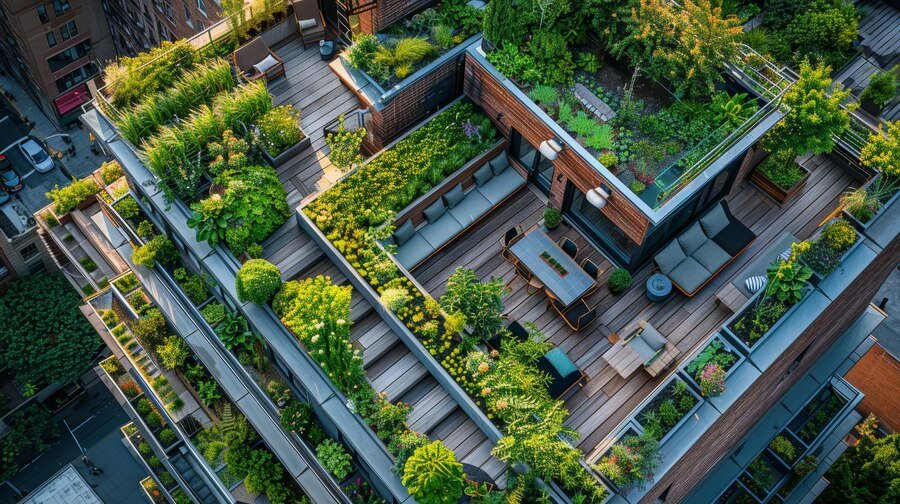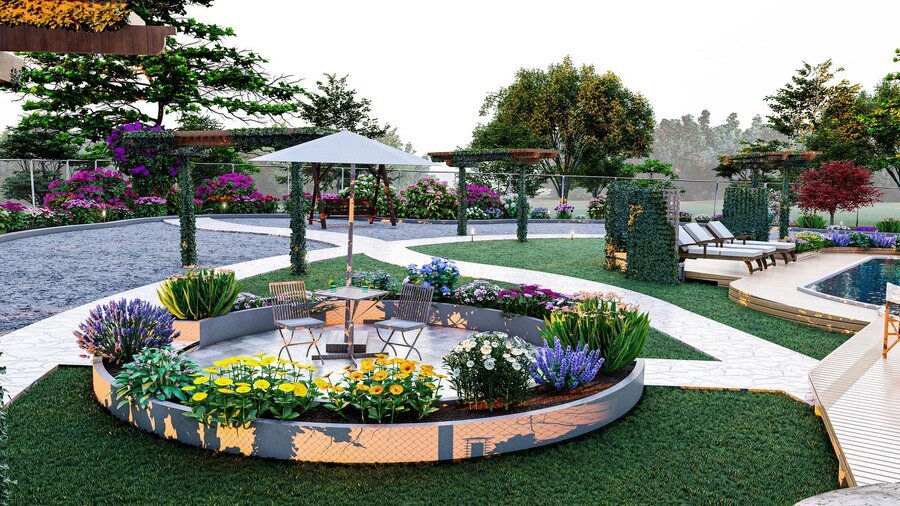Top Sustainable Landscaping Ideas to Transform Your Outdoor Space
Sustainable landscaping is an innovative approach that seeks to create beautiful outdoor spaces while minimizing environmental impact. By focusing on practices that promote ecological balance, water conservation, and biodiversity, sustainable landscaping is not just about aesthetics—it’s about creating a harmonious relationship between nature and human habitation. This article will explore various sustainable landscaping ideas that can transform your outdoor space into a thriving, eco-friendly environment.
1. Native Plant Selection
Why Choose Native Plants?
Native plants are those that occur naturally in a specific region and have adapted to the local climate, soil, and wildlife. Using native plants in your landscaping has several benefits:
- Low Maintenance: Native plants require less water and care than non-native species.
- Habitat Creation: They provide food and shelter for local wildlife, including birds, butterflies, and beneficial insects.
- Soil Health: Native plants often have deep root systems that improve soil structure and reduce erosion.
How to Incorporate Native Plants
- Research Local Flora: Start by identifying plants that are native to your area. Resources like local extension services or native plant societies can help.
- Create a Planting Plan: Design a planting layout that considers the growth habits of each plant, ensuring they have enough space to thrive.
- Use Native Plant Nurseries: Purchase your plants from local nurseries that specialize in native species to ensure they are well-suited to your region.
2. Xeriscaping

What is Xeriscaping?
Xeriscaping is a landscaping approach that reduces or eliminates the need for irrigation by using drought-resistant plants and efficient design techniques. This is particularly valuable in areas prone to drought or water shortages.
Xeriscaping Techniques
- Group Plants by Water Needs: Organize your garden by grouping plants with similar water requirements, making it easier to manage irrigation.
- Incorporate Mulch: Use organic mulch to retain soil moisture, suppress weeds, and add nutrients as it decomposes.
- Install Drip Irrigation: Consider a drip irrigation system to deliver water directly to the roots of plants, minimizing waste.
3. Edible Landscaping
What is Edible Landscaping?
Edible landscaping combines traditional ornamental plants with food-producing plants. This method not only enhances the beauty of your garden but also provides fresh fruits, vegetables, and herbs.
Ideas for Edible Landscaping
- Fruit Trees and Shrubs: Incorporate dwarf fruit trees or berry bushes into your landscape design.
- Herb Gardens: Create a dedicated herb garden using pots, raised beds, or borders around your property.
- Vegetable Patches: Designate an area for seasonal vegetable gardening, ensuring it receives adequate sunlight.
4. Rain Gardens

What is a Rain Garden?
A rain garden is a planted depression that collects and absorbs rainwater runoff from impervious surfaces, such as roofs and driveways. They help filter pollutants and replenish groundwater.
How to Create a Rain Garden
- Select the Right Location: Choose a spot that collects runoff but is at least 10 feet away from foundations.
- Design the Garden: The garden should be about 6 inches deep and have a sloped edge for easy access.
- Choose the Right Plants: Select native, water-loving plants that can thrive in wet conditions and tolerate dry periods.
5. Composting
What is Composting?
Composting is the process of recycling organic waste into a valuable soil amendment. By composting, you can reduce waste and improve soil health simultaneously.
How to Start Composting
- Choose a Compost Bin: Select a bin that suits your space and needs. Options range from tumblers to simple pile setups.
- Add Organic Material: Include kitchen scraps (vegetable peels, coffee grounds), yard waste (grass clippings, leaves), and cardboard.
- Maintain Your Compost: Turn the pile regularly to aerate it, and keep it moist but not soggy.
6. Green Roofs

What is a Green Roof?
A green roof involves covering a building’s roof with vegetation and soil. This practice helps reduce heat, manage stormwater, and improve air quality.
Benefits of Green Roofs
- Energy Efficiency: Green roofs provide insulation, reducing heating and cooling costs.
- Biodiversity: They create habitats for wildlife, including birds and insects.
- Stormwater Management: Green roofs absorb rainwater, reducing runoff and the risk of flooding.
How to Install a Green Roof
- Consult a Professional: Installing a green roof can be complex, so it’s advisable to hire a professional.
- Choose the Right Plants: Opt for drought-resistant and hardy plants that can thrive in a rooftop environment.
7. Permeable Paving
What is Permeable Paving?
Permeable paving refers to surfaces that allow water to pass through, reducing runoff and promoting groundwater recharge. This includes permeable concrete, pavers, and gravel.
Benefits of Permeable Paving
- Stormwater Management: Helps manage excess water during heavy rainfall.
- Reduced Erosion: Minimizes soil erosion and runoff.
- Aesthetic Appeal: Available in various styles and designs to complement your landscape.
Implementation of Permeable Paving
- Select the Right Materials: Choose materials that suit your aesthetic and functional needs.
- Proper Installation: Ensure the base layer is properly constructed for effective drainage.
8. Wildlife-Friendly Landscaping
What is Wildlife-Friendly Landscaping?
This approach focuses on creating a habitat for local wildlife, promoting biodiversity while enhancing your garden’s beauty.
Tips for Wildlife-Friendly Landscaping
- Provide Water Sources: Include birdbaths, ponds, or shallow dishes for birds and small animals.
- Create Shelter: Use native shrubs and plants to provide cover and nesting sites for wildlife.
- Limit Chemical Use: Reduce or eliminate pesticides and herbicides to protect beneficial insects and pollinators.
9. Vertical Gardening
What is Vertical Gardening?
Vertical gardening involves growing plants in vertical spaces, making it ideal for small gardens or urban environments.
Benefits of Vertical Gardening
- Space Saving: Maximizes limited space while providing a lush garden.
- Aesthetic Appeal: Creates visually appealing green walls or trellises.
- Improved Air Quality: Plants absorb carbon dioxide and release oxygen, enhancing air quality.
How to Start a Vertical Garden
- Choose the Right Plants: Opt for climbing plants, herbs, or flowers that thrive vertically.
- Select a Structure: Use trellises, wall planters, or hanging pots to create your vertical garden.
10. Sustainable Lawn Care
What is Sustainable Lawn Care?
Sustainable lawn care involves practices that maintain a healthy lawn while minimizing environmental impact.
Tips for Sustainable Lawn Care
- Mow High: Keep your grass taller to promote root growth and reduce water needs.
- Use Organic Fertilizers: Opt for natural fertilizers that improve soil health without chemical runoff.
- Water Wisely: Water early in the morning or late in the evening to minimize evaporation.
Also Read : Top 10 Creative Home Extension Ideas to Maximize Your Space
Conclusion
Transforming your outdoor space into a sustainable landscape is a rewarding endeavor that benefits both the environment and your personal well-being. By implementing these top sustainable landscaping ideas, you can create a beautiful, functional, and eco-friendly garden that enhances your home while promoting biodiversity and conservation.
Sustainable landscaping is not just a trend; it’s a necessary step towards a greener future. Whether you start small by adding native plants or go big with a green roof, every effort counts in making a positive impact on the environment.
FAQs
1. What are the benefits of sustainable landscaping?
Sustainable landscaping promotes ecological balance, reduces water consumption, improves air quality, and creates habitats for wildlife, all while enhancing the beauty of your outdoor space.
2. How can I start my sustainable landscaping journey?
Begin by assessing your current landscape and identifying areas for improvement. Research native plants, consider xeriscaping, and implement water-saving practices.
3. What are some easy ways to maintain a sustainable garden?
Use organic fertilizers, practice composting, water wisely, and choose low-maintenance native plants to create a sustainable garden that requires less upkeep.
4. Can I incorporate edible plants into my landscape?
Absolutely! Edible landscaping allows you to grow fruits, vegetables, and herbs alongside ornamental plants, enhancing both beauty and functionality.
5. Is sustainable landscaping expensive?
While some sustainable practices may have higher initial costs, many, like native planting and xeriscaping, save money in the long run due to reduced maintenance and water use.
